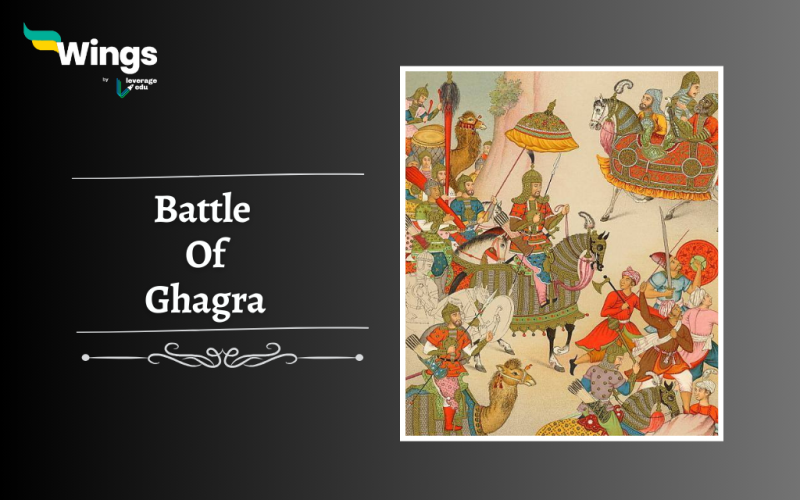The Battle of Ghagra was fought in 1529. It was a crucial battle in the Mughal Empire’s conquest of India. The battle came after the First Battle of Panipat, which took place in 1526, and the Battle of Khanwa in 1527. It was fought between Babur’s Mughal armies and Sultan Nusrat Shah’s Sultanate of Bengal forces. In this blog, we will learn more about this topic by summarising key information about the Battle of Ghaghra.
Table of Contents [show]
| Battle of Ghagra Overview | |
| Battle Took Place On | 1529 |
| Place | Ghagra |
| Fought Between | Mughal Empire Vs Sultanate of Bengal |
| Won By | Mughal Empire |
Monarchs in the Battle
Despite the fact that the battle of Khanwa had secured Babur’s position as Delhi’s undisputed monarch, he had still to face the remaining Afghan leaders. Muhammad Lodi, Ibrahim Lodi’s younger brother, was one of the most prominent among them.
Muhammad Lodi and Babur battled in the Battle of Ghaghra in 1529. In which the ruler of Bengal, Nusrat Shah, helped Muhammad Lodi. However, Babur was successful once more, consolidating his control throughout India.
Also Read – Battle Of Diu: Background, Event, Outcome & More
Background of the Battle
Mahmud Lodi declared himself the legitimate successor to the Delhi Sultanate, following the death of his brother, Sultan Ibrahim Lodi, at the second Battle of Panipat in 1526. His title was threatened following his defeat and escape in the Battle of Khanwa in 1527. Mahmud Lodi requested and received assistance from his Afghan relatives in the east. His troops, which included Eastern Afghan Confederates, conquered Bihar.
- The Pathan ruler of Bihar died after Sultan Mahmud Shah Lohani. His minor son Jalal ud-Din Lohani was crowned as the ruler. His mother Dudu, on the other hand, had a falling out with another noble, Farid Khan, better known as Sher Shah Suri.
- The Lohani nobles’ bickering distracted them from Babur’s approaching soldiers, forcing the young prince to seek refuge in the nearby sultanate of Bengal. The Afghans of Jaunpur asked Mahmud Lodi to seize the throne of Bihar and Jaunpur in order to prevent the state’s total collapse.
- He was able to seize control of the majority of Bihar without opposition after the approval.
- After hearing about the events in Bihar, Babur decided to march there with his army, and on February 27, 1529, he arrived at Dadaki on the banks of the Ganges, where he was welcomed by his son Humayun and General Askari.
- The Mughal army marched along the right side of the river soon after.
- Sultan Mahmud Lodi was in the Bengal camp with a huge force of Afghans. Babur learned through his spies in the camp that Mahmud Lodi’s request to have their families removed from the front lines was turned down by the Bengalis. They most likely wished to keep collateral in case Mahmud changed his mind.
- This behaviour was offensive to Babur, and their actions were disgusting. As a result, their impartiality was violated, giving him Casus Belli (cause for war) against the Bengalis.
Events of the Battle
Babur found the Bengal army, known as the Kherid army, between what is today the Saran region in the north.
- They set their tent on the Ganges’ left bank. He also learned that the Bengali generals had gathered around 100–150 vessels on their side of the stream, allowing them to simultaneously block an enemy’s passage while facilitating their own.
- With around 20,000 soldiers, Sultan Junaid Birlas from Jaunpur joined Babur.
- The army’s main body, led by Askari, was ordered to march down the river in order to attract the enemy out of the camp. They were supposed to divert the Bengali army long enough for a division led by Babur and Muhammad Zaman to cross the river with artillery and muskets.
- As soon as Askari’s army began to march on May 6, 1529, Babur ordered his whole division, as well as Zaman’s, to cross without delay. The Afghans tried numerous times to stop the river crossing but were quickly defeated by withering small arms and artillery fire.
- They soon found themselves being gradually encircled. on each of the three sides. However, before the encirclement could be completed, Afghan leaders decided to withdraw before their casualties became too high, and retreated. The Mughals won the battle of Ghaghra.
Also Read – Battle of Assaye: Background, Events & More
The Aftermath of The Battle of Ghaghra
The win had far-reaching consequences. The fight put an end to Afghan hopes for a separate kingdom in the east, as well as a proxy kingdom in Delhi.
- The rivalries between the Lodi and Lohani groups were enough to put an end to the idea of an independent Afghan kingdom.
- The Battle of Ghaghra was the last battle that Babur fought. He used jagirs (Estates) to distribute to loyal nobles and friends as he continued to solidify his rule and create an administration system in his new Empire.
- He died of an unexplained illness on December 26, 1530, at the age of 47, and was succeeded by his eldest son, Humayun.
Relevant Blogs
This was all about the Battle of Ghagra. For more content related to the different states of India, visit our articles like this, you can get Study notes on the Modern History of India here. Also, you can visit our general knowledge page on Indian History!
 One app for all your study abroad needs
One app for all your study abroad needs















 45,000+ students trusted us with their dreams. Take the first step today!
45,000+ students trusted us with their dreams. Take the first step today!
